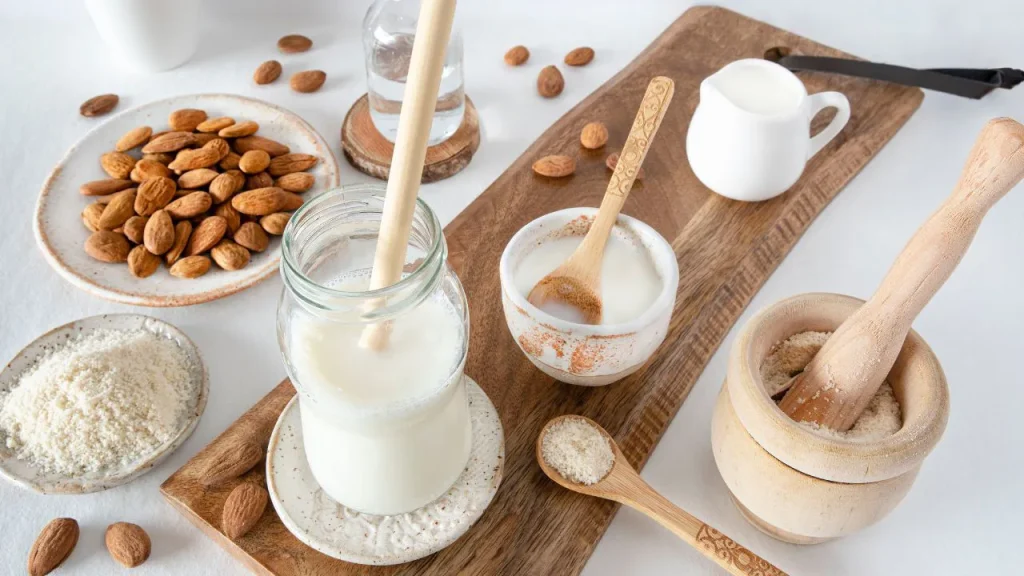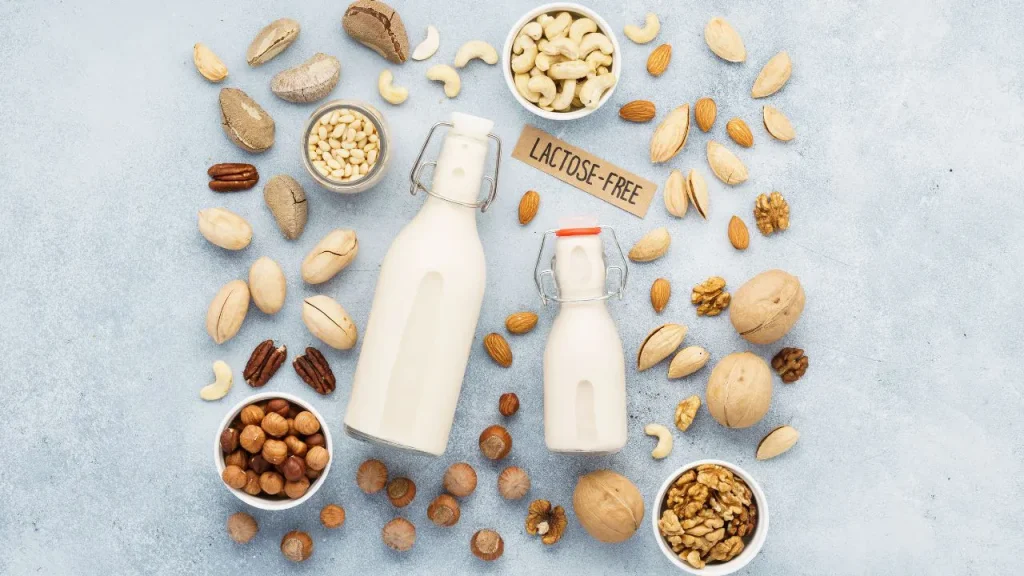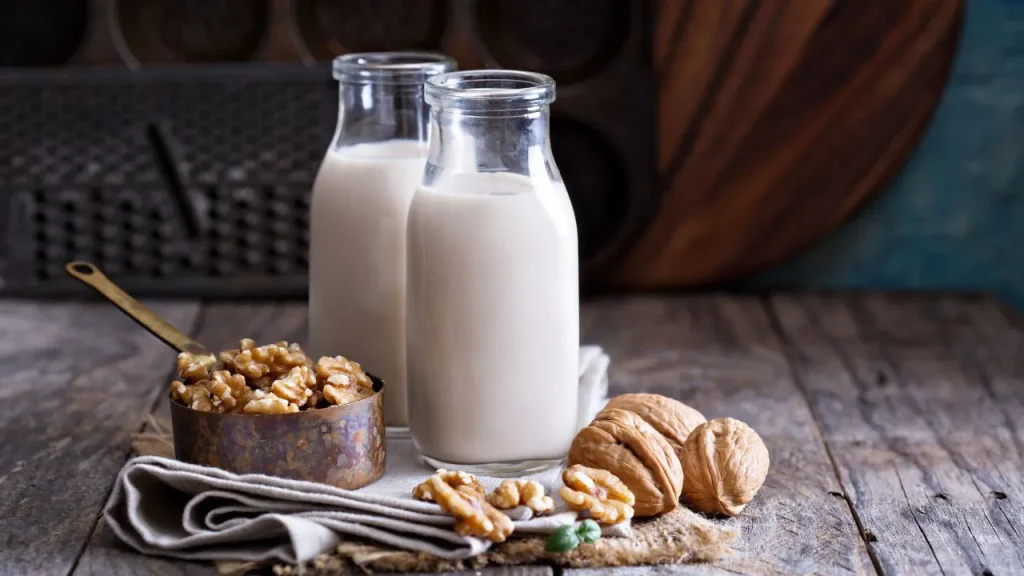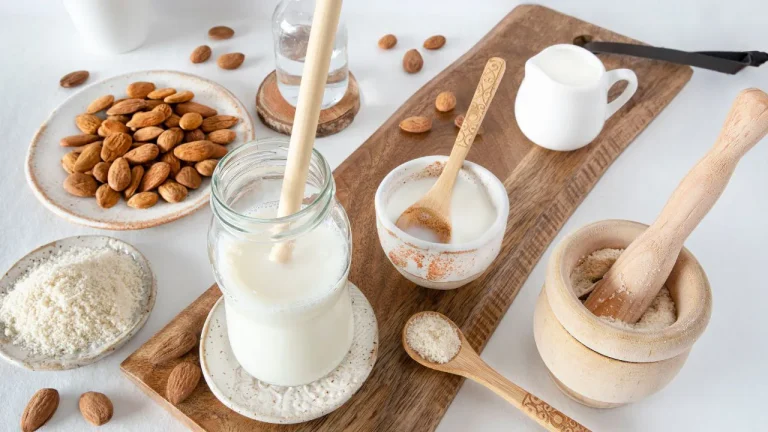If you’re anything like me, you love discovering new ways to enjoy healthier alternatives to traditional dairy. Recently, I’ve been experimenting with almond milk vanilla, and let me tell you, it’s been a game-changer! Making homemade almond milk is not only delicious but also offers numerous benefits over store-bought varieties. Today, I want to dive deep into everything you need to know about making almond milk, from its nutritional benefits to some fantastic recipes you can try.
What is Almond Milk Vanilla?
Almond milk vanilla is a delightful dairy-free beverage made from almonds and flavored with vanilla. It’s a creamy, slightly sweet alternative to traditional milk, making it perfect for anyone looking to cut back on dairy or those with lactose intolerance. Making it at home allows you to control the ingredients, ensuring you get a pure, additive-free drink that’s both delicious and nutritious. It’s a wonderful example of DIY almond milk that you can customize to your taste.
Certainly! Here’s a step-by-step section for making homemade almond milk, including variations like vanilla almond milk and chocolate almond milk.
How to Make Homemade Almond Milk: Step by Step

Making homemade almond milk is a straightforward process that yields a fresh, delicious, and customizable drink. Whether you’re making vanilla almond milk, chocolate almond milk, or just a basic nut milk, this guide will walk you through the steps. Let’s dive in!
Step 1: Gather Your Ingredients
Basic Ingredients:
- 1 cup raw almonds
- 4 cups water (plus more for soaking)
- 1-2 tablespoons sweetener (optional, e.g., honey, maple syrup)
- 1 teaspoon vanilla extract (for vanilla almond milk)
For Chocolate Almond Milk:
- 2-3 tablespoons unsweetened cocoa powder or 1/4 cup melted dark chocolate
For Vanilla Almond Milk:
- 1-2 teaspoons vanilla extract
Step 2: Soak the Almonds
- Soak the Almonds: Place 1 cup of raw almonds in a bowl and cover them with water. Allow the almonds to soak overnight or for at least 8 hours. This softens the almonds and makes them easier to blend, resulting in a smoother nut milk.
- Drain and Rinse: After soaking, drain the almonds and rinse them under cool running water. This helps to remove the enzyme inhibitors and any residue.
Step 3: Blend the Almonds
- Add Ingredients to Blender: Place the soaked and drained almonds in a high-speed blender. Add 4 cups of fresh water.
- Blend: Blend the mixture on high speed for about 1-2 minutes, or until the almonds are finely ground and the mixture appears creamy. If you’re making vanilla almond milk, add 1-2 teaspoons of vanilla extract before blending. For chocolate almond milk, add the unsweetened cocoa powder or melted dark chocolate to the blender before blending.
Step 4: Strain the Almond Milk
- Prepare the Strainer: Line a nut milk bag, cheesecloth, or fine mesh strainer over a large bowl or pitcher.
- Strain the Mixture: Pour the blended almond mixture through the lined strainer. Gently squeeze the nut milk bag or press the mixture with the back of a spoon to extract as much liquid as possible. The liquid collected is your homemade almond milk.
- Save the Pulp: The remaining almond pulp can be saved and used in baking or other recipes. It’s a great addition to homemade nut milk for baking or to make biscuit recipes with almond milk.
Step 5: Sweeten and Flavor (Optional)
- Add Sweeteners: Taste your almond milk and add sweetener if desired. Honey, maple syrup, or dates work well. Blend briefly to combine.
- Adjust Flavor: For vanilla almond milk, you can add a little more vanilla extract if desired. For chocolate almond milk, adjust the cocoa powder or chocolate to taste.
Step 6: Store Your Almond Milk
- Transfer to Container: Pour the strained almond milk into a clean, airtight container or bottle.
- Refrigerate: Store in the refrigerator for up to 3-5 days. Shake well before each use, as natural separation may occur.
- Freeze (Optional): For longer storage, you can freeze almond milk in ice cube trays or a freezer-safe container. Thaw in the refrigerator and shake well before use.
Tips and Tricks
- Nut Milk Hacks: For an extra creamy texture, blend the almond milk a bit longer. You can also adjust the water ratio to make it thicker or thinner based on your preference.
- Affordable Nut Milk: Making almond milk at home is significantly cheaper than buying it from the store. Plus, you get to enjoy a fresher, more customized product.
- Nut Milk Alternatives: If you prefer a different flavor, you can experiment with other nuts or seeds like cashews or sunflower seeds, following a similar process.
By following these steps, you can make delicious homemade almond milk that suits your taste and dietary needs. Whether you’re enjoying it as is, using it in recipes, or experimenting with different flavors, homemade almond milk is a fantastic addition to your kitchen.
Happy blending!
Homemade Nut Milk Nutrition

When it comes to homemade nut milk nutrition, almond milk stands out for several reasons:
- Low in Calories: Almond milk is generally lower in calories compared to cow’s milk. A cup of unsweetened almond milk typically contains around 30-50 calories, depending on the brand and any added ingredients. This makes it an excellent choice for those looking for a budget-friendly nut milk option.
- Rich in Vitamins and Minerals: Almond milk is a good source of vitamins and minerals, including vitamin E, which is an antioxidant that helps protect your cells from damage. It also contains calcium, which is essential for bone health, and magnesium, which supports muscle and nerve function. Homemade versions of almond milk can be fortified with these nutrients, especially when you make your own easy almond milk recipe.
- Low in Protein: One thing to note is that almond milk has less protein compared to cow’s milk. If you’re relying on nut milk as your primary milk source, make sure to balance your diet with other protein sources. This makes it a bit different from homemade nut milk recipes that use nuts with higher protein content.
- No Cholesterol: Almond milk is naturally cholesterol-free, making it a heart-healthy option compared to whole milk. Plus, making it at home ensures that there are no added unhealthy fats or cholesterol.
Making DIY nut milk allows you to avoid added sugars and preservatives commonly found in store-bought versions. You can tailor the sweetness and flavor to your preference, making it a versatile addition to your diet.
Variations of Almond Milk

One of the best things about almond milk is its versatility. You can create various variations to suit your taste preferences and dietary needs. Here are some popular options:
Coconut Almond Milk

Check my Blackberry Banana Smoothie Recipe: A Refreshing and Healthy Treat
If you love the flavor of coconut, coconut almond milk is a fantastic variation. This blend combines the nutty taste of almonds with the tropical richness of coconut. To make it, simply add a splash of coconut milk or coconut cream to your almond milk recipe. It adds a creamy texture and a subtle coconut flavor that’s perfect for smoothies or lattes. It’s an easy way to create a creamy nut milk recipe at home.
Chocolate Almond Milk Recipe
For a decadent treat, try making chocolate almond milk. It’s perfect for when you’re craving something sweet and indulgent. Here’s a simple recipe:
- Ingredients:
- 4 cups of homemade almond milk
- 2-3 tablespoons of unsweetened cocoa powder (or 1/4 cup of melted dark chocolate)
- Sweetener to taste (e.g., honey, maple syrup)
- Instructions:
- Heat the almond milk in a saucepan over medium heat.
- Stir in the cocoa powder or melted chocolate until fully dissolved.
- Add sweetener to taste and mix well.
- Serve warm or chilled.
This chocolate almond milk is great for enjoying on its own or as a base for chocolate-flavored recipes. It’s a great example of how you can use DIY nut milk to make delicious treats.
Almond Milk Latte Recipe
If you’re a coffee lover, you’ll appreciate a good almond milk latte. It’s a dairy-free alternative that doesn’t skimp on flavor. Here’s how to make it:
- Ingredients:
- 1 shot of espresso or 1/2 cup of strong brewed coffee
- 1 cup of almond milk
- Sweetener to taste (optional)
- Ground cinnamon or vanilla extract (optional)
- Instructions:
- Brew your espresso or coffee and set aside.
- Heat the almond milk in a saucepan until steaming.
- Froth the milk using a frother or whisk.
- Pour the coffee into a mug and top with the frothed almond milk.
- Add a sprinkle of cinnamon or a splash of vanilla if desired.
This almond milk latte recipe is perfect for a morning pick-me-up or an afternoon break. It’s creamy, satisfying, and full of flavor.
Biscuit Recipe with Almond Milk
Almond milk isn’t just for drinks—it can also be used in baking. Here’s a tasty biscuit recipe with almond milk:
- Ingredients:
- 2 cups all-purpose flour
- 1 tablespoon baking powder
- 1/2 teaspoon salt
- 1/4 cup cold butter
- 3/4 cup almond milk
- Instructions:
- Preheat your oven to 425°F (220°C).
- In a large bowl, combine flour, baking powder, and salt.
- Cut in the cold butter until the mixture resembles coarse crumbs.
- Stir in the almond milk until just combined.
- Roll out the dough on a floured surface and cut into rounds.
- Bake for 12-15 minutes or until golden brown.
These biscuits are light, fluffy, and perfect for serving with soups, stews, or just as a snack. It’s an excellent example of how homemade almond milk can enhance your baked goods.
Crepes with Almond Milk Recipe
For a special breakfast or brunch, try crepes with almond milk. They’re light, tender, and easy to make:
- Ingredients:
- 1 cup all-purpose flour
- 2 large eggs
- 1 cup almond milk
- 1 tablespoon melted butter
- A pinch of salt
- Instructions:
- In a bowl, whisk together flour, eggs, almond milk, and melted butter until smooth.
- Heat a non-stick skillet over medium heat and lightly grease it.
- Pour a small amount of batter into the skillet and swirl to cover the bottom evenly.
- Cook for 1-2 minutes on each side or until golden brown.
- Serve with your favorite toppings, such as fresh fruit, syrup, or powdered sugar.
These crepes with almond milk are versatile and can be customized with sweet or savory fillings.
French Toast with Almond Milk Recipe
Finally, for a comforting breakfast, french toast with almond milk is a great option. Here’s how to make it:
- Ingredients:
- 1 cup almond milk
- 2 large eggs
- 1 teaspoon vanilla extract
- 1/2 teaspoon ground cinnamon
- 6 slices of bread
- Instructions:
- In a bowl, whisk together almond milk, eggs, vanilla extract, and cinnamon.
- Heat a skillet or griddle over medium heat and lightly grease it.
- Dip each slice of bread into the mixture, coating both sides.
- Cook in the skillet for 2-3 minutes on each side or until golden brown.
- Serve with fresh berries, maple syrup, or a dusting of powdered sugar.
This french toast with almond milk recipe is perfect for a hearty breakfast or brunch.
Can Almond Milk Cause Constipation?
There’s been some discussion about whether almond milk can cause constipation. Generally, almond milk is not known to cause constipation. In fact, almonds contain fiber, which can aid in digestion. However, individual reactions can vary.
If you’re experiencing constipation and suspect it might be related to your almond milk intake, consider these points:
- Portion Size: Consuming large amounts of any type of milk, including almond milk, could potentially lead to digestive issues. Moderation is key.
- Balanced Diet: Make sure you’re also eating a balanced diet rich in fiber from fruits, vegetables, and whole grains. A lack of overall fiber can contribute to constipation.
- Hydration: Staying well-hydrated is crucial for preventing constipation. Drink plenty of water throughout the day.
If you continue to experience issues, it might be helpful to consult with a healthcare provider to rule out any underlying conditions.
FAQs About Almond Milk
1. Is almond milk a good source of calcium?
Yes, many commercial almond milks are fortified with calcium, making them a good source of this essential mineral. Homemade versions of almond milk can be fortified with calcium if needed. This is particularly useful for those relying on **homemade nut milk for baking** or other recipes.
2. How long does homemade almond milk last?
Homemade nut milk typically lasts about 3-5 days in the refrigerator. Be sure to store it in a clean, airtight container and shake well before each use. If you have any nut milk leftovers, you can use them in other recipes like smoothies or baking.
3. Can almond milk be frozen?
Yes, almond milk can be frozen, but it may separate upon thawing. To freeze, pour almond milk into an ice cube tray or a freezer-safe container. Thaw in the refrigerator and shake or blend to re-emulsify before use.
4. Can I use almond milk in baking?
Absolutely! Almond milk can be used in most baking recipes as a dairy substitute. It works well in recipes for cakes, muffins, and biscuits, just like in the biscuit recipe with almond milk we mentioned earlier. It’s a great way to make your baking more budget-friendly.
5. What’s the best way to sweeten homemade almond milk?
You can sweeten homemade almond milk with natural sweeteners like honey, maple syrup, or dates. Adding a splash of vanilla extract also enhances the flavor. For a more affordable nut milk, you might opt for simple sweeteners you have on hand.
Conclusion
I hope this deep dive into almond milk vanilla has inspired you to try making it at home and experiment with all the fantastic recipes we’ve covered. From its nutritional benefits to creative variations like chocolate almond milk and almond milk lattes, homemade almond milk offers endless possibilities.
Whether you’re looking for a dairy-free drink, a new ingredient for baking, or a cozy treat, almond milk has something for everyone. Remember, making it yourself means you can control the ingredients and tailor the flavor to your liking. Plus, it’s a fun and rewarding way to enjoy a delicious, healthy alternative to traditional dairy. And with options like cheap nut milk recipes and easy nut milk recipes, it’s also a great way to save money.
Give these recipes a try and let me know how they turn out. I’d love to hear about your experiences with homemade nut milk and any unique variations you come up with. Here’s to enjoying the creamy, nutty goodness of almond milk in all its forms!
Happy sipping and baking!
Feel free to adjust any part of the post to better fit your style or specific needs. Enjoy sharing your almond milk adventures!




Pingback: What is the Moon Diet? Guide to Feeling Great
Pingback: Keto Diet: Everything You Need to Know » Stoner Food Heaven